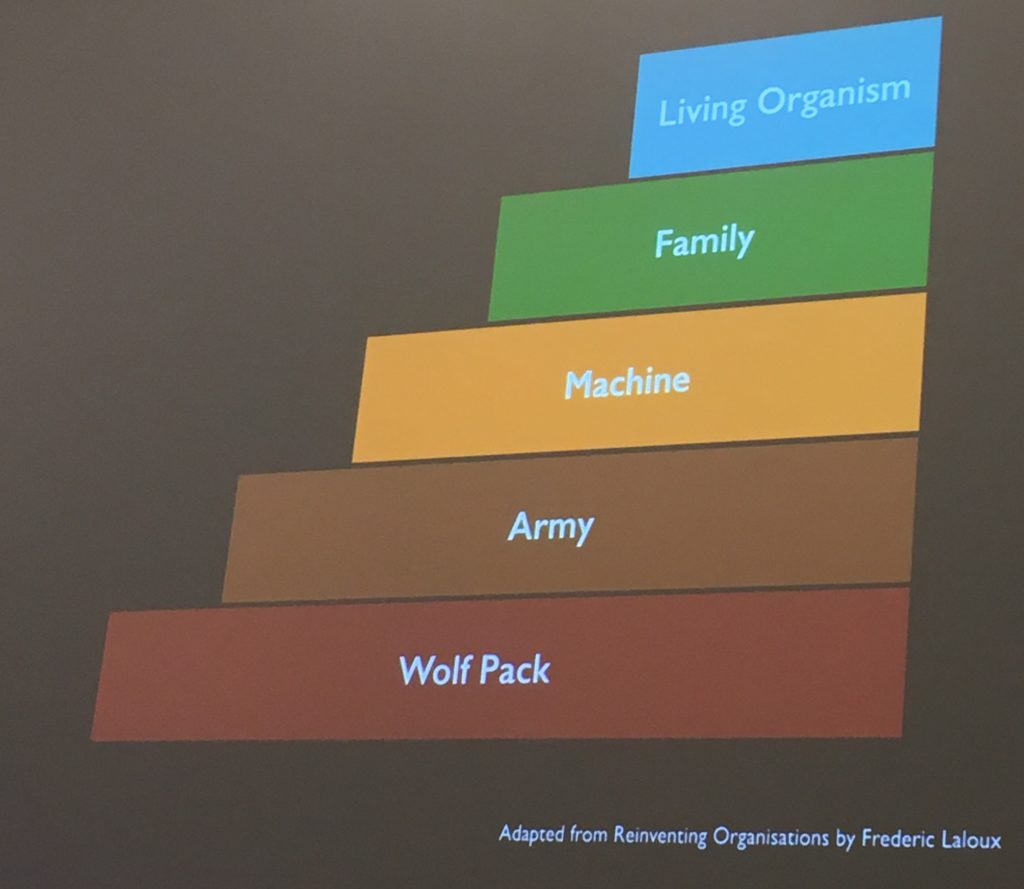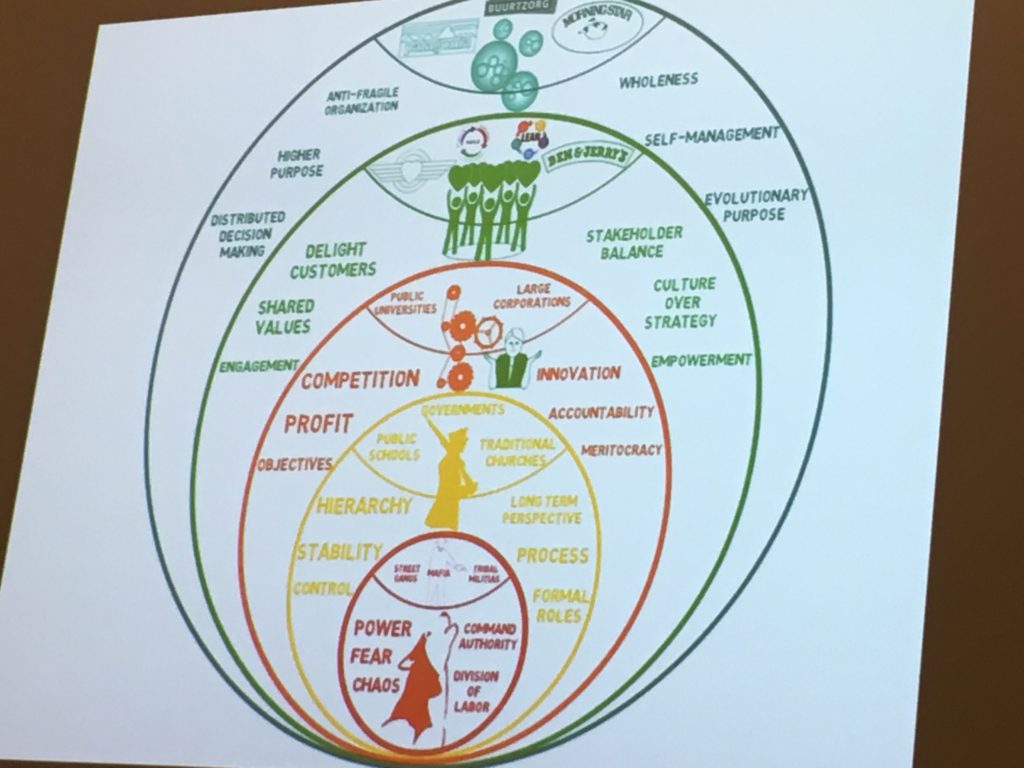Following the spiral dynamics of infrared to ultraviolet light, Frederic looks to give a new categorization of businesses. From bottom to top, we have the following states of consciousness available in an organization:
- Red: The Wolf Pack: This is a misnomer because wolves act more like families, but in this situation the Wolf Pack thrives on chaos, anarchistic.
- Amber: Army: This includes organizations led by great formality, like the Catholic Church and the actual military. (Though it’s been pointed out that often the best results from a military operation comes from self-organization.)
- Orange: Machine: This is the most common today, focusing constantly on “resources” (like allocating human resources) and controlling. This is also very empirical and scientific, focused on experimentation sometimes, but measurement always.
- Green: Family: This is the Zappos and Ben & Jerry’s model, filled with value statements and familial vibe, though maybe not all egalitarian as it seems.
- Teal: Living Organism: Something that’s transcending and releasing power and control, trusting that workers are able to organize and motivate themselves. The book is made up of deep dives into 12 companies that have reached Teal.
- Turquoise: Higher Consciousness: This isn’t really described yet or clarified, and not featured in the image above, but the idea is that it’s that next level. Though so few organizations have reached teal, so maybe not important yet, but you gotta have goals!

When I sat down with Teal culture coaches Ash Sheikh and Tobias Mayer, and later saw Tobias’ talk at a local Meetup, it was clear that they believe in the idea behind Frederic’s message, but they particularly are attracted to the fact that it isn’t too prescriptive.
How can you talk about change if you don’t have the language to guide you?
Tobias reframes above the conversation around teal and other organization classification, implying that it’s a continuous cycle of learning in which everyone is involved, a constant evolution toward maturing to teal. Add to this the Frederic’s recommendation that you get C-level buy-in for this — which of course without it, any change would fail — but then top-down management doesn’t seem very teal, does it?
But what does it mean to reach this level of maturity?
The three breakthroughs of the Teal paradigm:
- evolutionary purposes – organizations evolve on their own and there’s no need to control and predict that future
- self-management – completely without hierarchy or a need for consensus
- wholeness – there isn’t one person at work and another at home, work-life balance
This is easier said than done. Beyond the hurdle of management buy-in, it’s nearly impossible to jump levels because it’s nearly impossible to change a contract you’ve had with current employees and culture. People genuinely may have signed onto a company that instructs them because that’s what they are comfortable with. This means the advice process that goes into self-management can be stunted by people who simply don’t want to make decisions.
Where you start and where you end up truly depends on your company culture and your team.
How do agile and teal differ?
First a lot of software development focuses on resource allocation with story points, sprints and hours, treating humans as resources. Tobias offers that agile struggles to link with Teal because it’s all about releasing control and power, not looking at resources so much.
More than anything, Tobias says that, in a world of very prescribed agile language, with Teal, probably on purpose, “We don’t have the language or the artifacts to explore this space. Agile has become a whole mechanical diagram now, anchored in this Orange paradigm, this mechanical mindset.”
Sure, there are agile companies that fall under green but he continued to warn that “Green is an orange paradigm with a smile — [these companies] talk about values as if saying the words somehow changes the work.”

At one point, Tobias even put up a photo of a blank sheet of paper, dubbing that the Language of Teal.
That also makes it a harder sell so far, meaning Teal coaches are still contacted by far more consultants than owners of companies, who are looking for the “this is like that” to make sense of the newer management model, which isn’t really a model at all, but rather a conversation.
For Tobias, the essence of a Teal organization is accepting one reality: “People talk about how managers need to motivate. People don’t need to motivate people — just leave them alone.”
Teal — and any good management plan really — is about realizing, assuming and accepting that people are naturally motivated because we’ve spend years and decades demotivating people.
In the end, Tobias said the language we should use is rather Platonic: “The language of not knowing.” He does admit this is challenging since most of us are knowledge workers.
He says it all comes down to un-training people who have spend our lives working to reduce uncertainly and manage risk.
Changing our metaphors and how we talk about our organizations and teammates won’t be easy, but it can start by stop trying to frame it except around asking more questions.












Replies to This Discussion